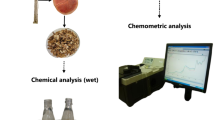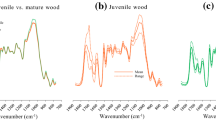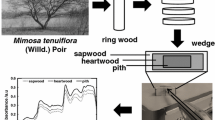Abstract
Determination of quality parameters such as lignin and extractive content of wood samples by wet chemistry analyses takes a long time. Near-infrared (NIR) spectroscopy coupled with multivariate calibration offers a fast and nondestructive alternative to obtain reliable results. However, due to the complexity of the NIR spectra, some wavelength selection is generally required to improve the predictive ability of multivariate calibration methods. Pinus brutia Ten. is the most growing pine species in Turkey. Its rotation period is around 80 years; the forest products industry has widely accepted the use of Pinus brutia Ten. because of its ability to grow on a wide range of sites and its suitability to produce desirable products. Pinus brutia Ten. is widely used in construction, window door panel, floor covering, etc. Determination of lignin and extractive content of wood provides information to tree breeders on when to cut and how much chemicals are needed for the pulping and bleaching process. In this study, 58 samples of Pinus brutia Ten. trees were collected in Isparta region of Turkey, and their lignin and extractive content were determined with standard reference (TAPPI) methods. Then, the same samples were scanned with near-infrared spectrometer between 1,000 and 2,500 nm in diffuse reflectance mode, and multivariate calibration models were built with genetic inverse least squares method for both lignin and extractive content using the concentration information obtained from wet standard reference method. Overall, standard error of calibration (SEC) and standard error of prediction (SEP) ranged between 0.35% (w/w) and 2.40% (w/w).





Similar content being viewed by others
References
Arnold SA, Crowley J, Vaidyanathan S, Matheson L, Mohan P, Hall JW, Harvey LM, McNeil B (2000) At-line monitoring of a submerged filamentous bacterial cultivation using near infrared spectroscopy. Enzyme Microb Tech 27:691–697
Cogdill RP, Schimleck LR, Jones PD (2004) Estimation of the physical wood properties of Pinus taeda L. radial strips using least squares support vector machines. J Near Infrared Spec 12(4):263–269
Delwiche SR (1998) Protein content of single kernels of wheat by near-infrared reflectance spectroscopy. J Cereal Sci 27(3):241–254
DeThomas FA, Hall JW, Monfre SL (1994) Real-time monitoring of polyurethane production using near infrared spectroscopy. Talanta 41:425–431
Ferré J, Rius FX (1996) Selection of the best calibration sample subset for multivariate regression. Anal Chem 68:1565–1571
Ferrioa JP, Villegasb D, Zarcob J, Apariciob N, Arausc JL, Royob C (2005) Assessment of drum wheat yield using visible and near-infrared reflectance spectra of canopies. Field Crops Res 94(2–3):126–148
Hareland GA (1994) Evaluation of flour particle size distribution by laser diffraction, sieve analysis and near-infrared reflectance spectroscopy. J Cereal Sci 20(2):183–190
Hedrick SE, Bennett RM, Rials TG (2007) Correlation of near-infrared spectroscopy measurements with the properties of treated wood. J Mater Civil Eng 19(4):279–285
Hibbert DB (1993) Genetic algorithms in chemistry. Chem Intell Lab Syst 19:277–293
Jones PD, Schimleck LR, Peter GF, Daniels RF, Clark A III (2006) Nondestructive estimation of wood chemical composition of sections of radial wood strips by diffuse reflectance near infrared spectroscopy. Wood Sci Technol 40:709–720
Jonsson P, Sjostrom M, Wallbacks L (2004) Strategies for implementation and validation of on-line models for multivariate monitoring and control of wood chip properties. J Chemometr 18(3–4):203–207
Kalivas JH (1997) Two data sets of near infrared spectra. Chem Intell Lab Syst 37(2):255–259
Kelley SS, Rials TG, Snell R, Groom LH, Sluiter A (2004) Use of near infrared spectroscopy to measure the chemical and mechanical properties of solid wood. Wood Sci Technol 38:257–276
McCaig TN (2002) Extending the use of visible/near-infrared reflectance spectrophotometers to measure colour of food and agricultural products. Food Res Int 35(8):731–736
McClure WF (1994) Near infrared spectroscopy-the giant is running. Anal Chem 66:43A–53A
Miralbés C (2004) Quality control in the milling industry using near infrared transmittance spectroscopy. Food Chem 88:622–628
Mosley RM, Williams RR (1998) Determination of the accuracy and efficiency of genetic regression. Appl Spectrosc 52:1197–1202
Özdemir D (2005) Determination of octane number of gasoline using near infrared spectroscopy and genetic multivariate calibration methods. Petroleum Sci Technol 23:1139–1152
Özdemir D (2006) Genetic multivariate calibration for near infrared spectroscopic determination of protein, moisture, dry mass, hardness and other residues of wheat. Inter J Food Sci Tech 41(Suppl 2):12–20
Özdemir D, Dinç E (2004) Determination of thiamine HCl and pyridoxine HCl in pharmaceutical preparations using uv–visible spectrophotometry and genetic algorithm based multivariate calibration methods. Chem Pharm Bull 52(7):810–817
Özdemir D, Öztürk B (2004) Genetic multivariate calibration methods for near Infrared (NIR) spectroscopic determination of complex mixtures. Turk J Chem 28:497–514
Özdemir D, Williams RR (1999) Multi-instrument calibration in uv-visible spectroscopy using genetic regression. Appl Spectrosc 53:210–217
Paradkar RP, Williams RR (1997) Genetic regression as a calibration technique for solid phase extraction of dithizone-metal chelates. Appl Spectrosc 51:92–100
Pizarro MC, Forina M, Casolino MC, Leardi R (1998) Extraction of representative subsets by potential functions methods and genetic algorithms. Chem Intell Lab Syst 40:33–51
Poke F, Raymond CA (2006) Predicting extractives, lignin, and cellulose contents using near infrared spectroscopy on solid wood in eucalyptus globulus. J Wood Chem Tech 26:187–199
Punchwein G, Eibelhuber A (1989) Outlier detection in routine analysis of agricultural grain products by near-infrared spectrometry. Anal Chim Acta 223:95–103
Schimleck LR, Kube PD, Raymond CA (2006) Extending near infrared reflectance (NIR) pulp yield calibrations to new sites and species. J Wood Chem Technol 26(4):299–311
So CL, Eberhardt TL (2006) Rapid analysis of inner and outer bark composition of Southern Yellow Pine bark from industrial sources. Holz Roh-Werkst 64(6):463–467
Sorvaniemi J, Kinnunen A, Tsados A, Mälkki Y (1993) Using partial least squares regression and multiplicative scatter correction for FT-NIR data evaluation of wheat flours. Food Sci Tech 26(3):251–258
Sykes R, Li B, Hodge G, Goldfarb B, Kadla JF, Chang H-M (2005) Prediction of loblolly pine wood properties using transmittance near-infrared spectroscopy. Can J For Res 35:2423–2431
Tran CD, Oliveira D, Grishko VI (2004) Determination of enantiomeric compositions of pharmaceutical products by near-infrared spectrometry. Anal Biochem 325:206–214
Tsuchikawa S, Hirashima Y, Sasaki Y (2005) Near-infrared spectroscopic study of the physical and mechanical properties of wood with meso- and micro-scale anatomical observation. Appl Spect 59(1):86–93
Yeh T, Yamada T, Capanema E, Chang HM, Chiang V, Kadla JF (2005) Rapid screening of wood chemical component variations using transmittance near-infrared spectroscopy. J Agric Food Chem 53:3328–3332
Zobel B, Talbert J (1984) Applied forest tree improvement. Wiley Interscience, New York
Zobel BJ, van Buijtenen JP (1989) Wood variation: its causes and control. Springer, Berlin
Acknowledgments
This project was funded by TUBITAK (The Scientific and Technological Research Council of Turkey Project No 105O524). The authors also thank Isparta Regional Forest Service, Ağlasun Forest Service and Asağıgökdere Forest Service for their support in providing wood samples, and Izmir Institute of Technology for the financial support of purchasing the near-infrared spectrometer.
Author information
Authors and Affiliations
Corresponding author
Rights and permissions
About this article
Cite this article
Üner, B., Karaman, İ., Tanrıverdi, H. et al. Determination of lignin and extractive content of Turkish Pine (Pinus brutia Ten.) trees using near infrared spectroscopy and multivariate calibration. Wood Sci Technol 45, 121–134 (2011). https://doi.org/10.1007/s00226-010-0312-z
Received:
Published:
Issue Date:
DOI: https://doi.org/10.1007/s00226-010-0312-z




